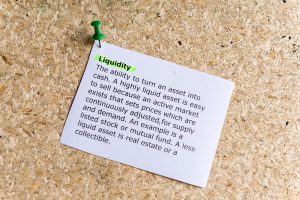Nelson Capital Management


As a registered investment advisor, we have a duty to our clients to seek best execution on all portfolio transactions. In order to do this, we take into account fees, price, liquidity and speed of execution. The prescription for best execution is not always the same. What works for one stock might not work for another. We rely on our expertise to properly manage our trading in order to achieve best execution every time we trade.
If we are trying to buy Cisco (tkr: CSCO), we look at the “market” for Cisco stock, which is quoted in terms of a bid price (the price at which a market maker is willing to buy) and an ask price (the price at which a market maker is willing to sell). (For further reading on this subject, see “Understanding Market Liquidity”) As investors and market makers buy and sell Cisco’s stock throughout the day, the bid and ask prices move up and down in tandem. Generally, if Cisco’s stock price is falling, there are more trades at the bid price, and if Cisco’s stock price is rising, there are more trades at the ask price.
We strive to avoid “moving the market” up or down when we are buying or selling shares. Cisco trades roughly 25 million shares daily, so 10,000 shares would likely will not move the market up or down. However, for a stock like Sun Hydraulics (tkr: SNHY) that only trades about 80,000 shares per day, a 10,000 share trade would be 1/8 of the total daily volume. Buying or selling 10,000 shares of SNHY would move the market, adversely affecting our execution.
 Think of liquidity as a spectrum, with Cisco being an example of a stock at the “very liquid” end, and Sun Hydraulics being an example of a stock at the “less liquid” end. Though there are other factors involved, for simplicity’s sake, we look at the average daily volume of the stock to get an idea of its liquidity. For Cisco, we enter a “market order” to complete a trade at the current market price. Given Cisco’s high liquidity, we can typically complete the trade quickly without moving the market. For a less liquid stock, we have to be extremely patient, which could mean taking all day (or longer) to execute the order. Our objective is to complete a trade for all accounts on the same day. When a stock is so illiquid that it could take more than one day, we negotiate the trade with the “high-touch” trading desks to complete the execution. In those rare cases, we may pay a higher trade processing fee through a Delivery Versus Payment or prime trade in order to get a better price on the entire order.
Think of liquidity as a spectrum, with Cisco being an example of a stock at the “very liquid” end, and Sun Hydraulics being an example of a stock at the “less liquid” end. Though there are other factors involved, for simplicity’s sake, we look at the average daily volume of the stock to get an idea of its liquidity. For Cisco, we enter a “market order” to complete a trade at the current market price. Given Cisco’s high liquidity, we can typically complete the trade quickly without moving the market. For a less liquid stock, we have to be extremely patient, which could mean taking all day (or longer) to execute the order. Our objective is to complete a trade for all accounts on the same day. When a stock is so illiquid that it could take more than one day, we negotiate the trade with the “high-touch” trading desks to complete the execution. In those rare cases, we may pay a higher trade processing fee through a Delivery Versus Payment or prime trade in order to get a better price on the entire order.
For example, if we need to buy 10,000 shares of Sun Hydraulics, the broker might know of a seller who is looking to execute a similar amount. The broker can help match our trade against the seller to complete the trade quickly and efficiently. Alternatively, the broker might agree to offer us the shares at a price slightly higher than the current ask price, in exchange for taking on the trading risk. By paying the broker’s slightly higher price, we avoid the uncertainty of the stock moving before we are able to execute our entire order. This is preferable to the scenario where being patient enough not to move the market could take several days or weeks, during which time the stock could move significantly on news or other events.
Individual investment positions detailed in this post should not be construed as a recommendation to purchase or sell the security. Past performance is not necessarily a guide to future performance. There are risks involved in investing, including possible loss of principal. This information is provided for informational purposes only and does not constitute a recommendation for any investment strategy, security or product described herein. Employees and/or owners of Nelson Roberts Investment Advisors, LLC may have a position securities mentioned in this post. Please contact us for a complete list of portfolio holdings. For additional information please contact us at 650-322-4000.
Receive our next post in your inbox.